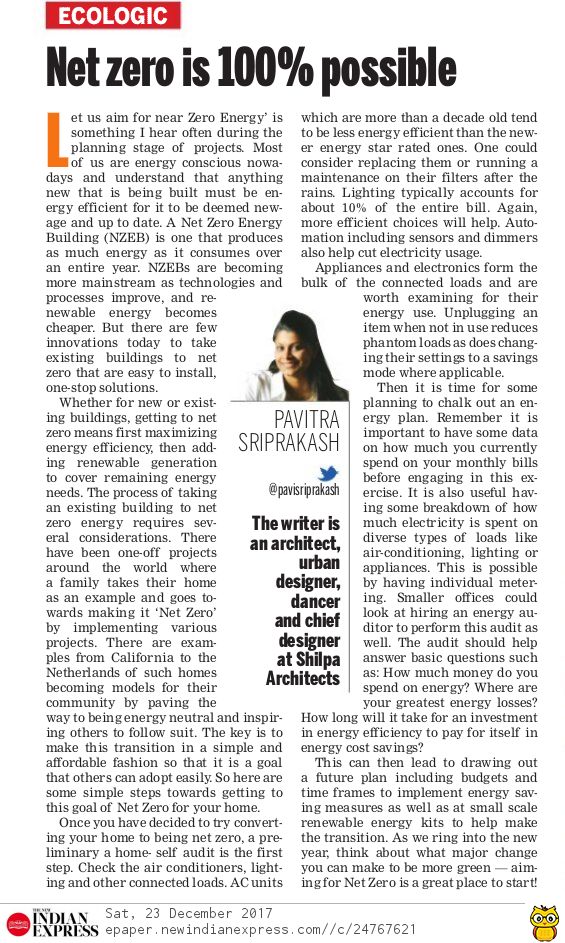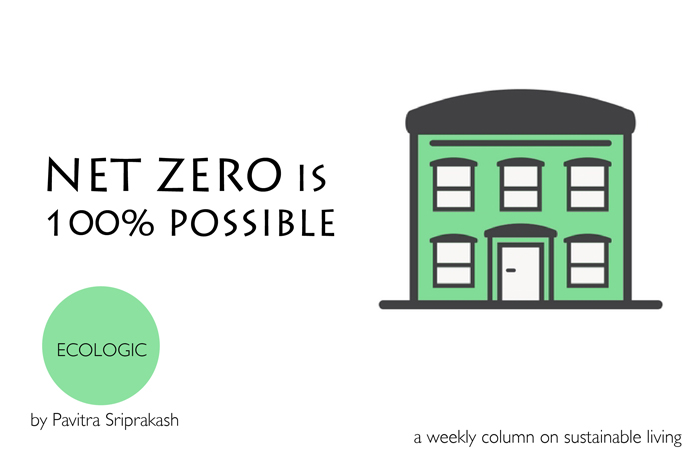December 23rd 2017, New Indian Express: ECOLOGIC- Pavitra Sriprakash, the Chief Designer and Director of Shilpa Architects writes on Net Zero buildings.
Full Article
Let us aim for near Zero Energy is something I hear often during the planning stage of projects. Most of us are energy conscious now-a-days and understand that anything new that is being built must be energy efficient for it to be deemed new age and up to date. A Net Zero Energy Building (NZEB) is one that produces as much energy as it consumes over an entire year. NZEBs are becoming more mainstream as technologies and processes improve, and renewable energy becomes cheaper. But there are few innovations today to take existing buildings to net zero that are easy to install, one stop solutions.
Whether for new or existing buildings, getting to net zero means first maximizing energy efficiency, then adding renewable generation to cover remaining energy needs. The process of taking an existing building to net zero energy requires several considerations. There have been one-off projects around the world where a family takes their home as an example and goes towards making it ‘Net Zero’ by implementing various projects. There are examples from California to the Netherlands of such homes becoming models for their community by paving the way to being energy neutral and inspiring others to follow suit. The key is to make this transition in a simple and affordable fashion so that it is a goal that others can adopt easily.So here are some simple steps towards getting this goal of Net Zero for your home.

Once you have decided to try converting your home to being net zero, a preliminary home- self audit is the first step. Check the air conditioners, lighting and other connected loads. AC units which are more than a decade old tend to be less energy efficient than the newer energy star rated ones. One could consider replacing them or running a maintenance on their filters after the rains. Lighting typically accounts for about 10% of the entire bill. Again, more efficient choices will help. Automation including sensors and dimmers also help cut electricity usage.
Appliances and electronics form the bulk of the connected loads and are worth examining for their energy use. Unplugging an item when not in use reduces phantom loads as does changing their settings to a savings mode where applicable.
Then it is time for some planning to chalk out an energy plan. Remember it is important to have some data on how much you currently spend on your monthly bills before engaging in this exercise. It is also useful having some breakdown of how much electricity is spent on diverse types of loads like air conditioning, lighting or appliances. This is possible by having individual metering. Smaller offices could look at hiring an energy auditor to perform this audit as well. The audit should help answer basic questions such as : How much money do you spend on energy? What are your greatest energy losses?How long will it take for an investment in energy efficiency to pay for itself in energy cost savings?
This can then lead to drawing out a future plan including budgets and time frames to implement energy saving measures as well as at small scale renewable energy kits to help make the transition. As we ring into the new year, think about what major change you can make to be more green – aiming for Net Zero is a great place to start.
About the Author
Pavitra Sriprakash (@pavisriprakash), the Director and Chief Designer of Shilpa Architects, is an Architectt, Urban Designer, Dancer and Artist. She writes a weekly sustainability column for The New Indian Express titled ECOLOGIC.



